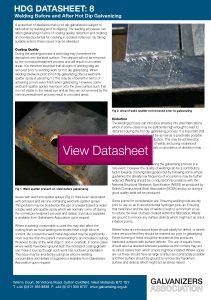A proportion of steelwork that is hot dip galvanized is subject to fabrication by welding prior to dipping. The welding processes can affect galvanizing in terms of coating quality, distortion and creating an increased potential for cracking in isolated instances. By taking suitable actions these issues may be alleviated.
High quality welds can be made on galvanized steel
Tests at The Welding Institute sponsored by the International Lead Zinc Research Organisation (ILZRO) have established that satisfactory high quality welds can be made on hot dip galvanized steel and that the tensile, bend and fatigue properties of such welds can be virtually identical to those of similar welds made on uncoated steel. Welding speeds are slower and there is more spatter, particularly when CO2 = welding.
All the fusion welding processes can readily be used on galvanized steel but minor variations in technique may be required depending on the welding process used, the type of joint and the welding position.
All welds made in galvanized articles should be protected against rust as soon as welding is finished, as the top surface is then free from rust and easy to treat.
For example, with manual metal arc welding:
- A slight ‘whipping’ action moving the electrode forward and backward along the line of the joint encourages volatization of the zinc in front of the weld pool.
- Slightly wider gaps are recommended in butt joints to give complete penetration.
- A short arc length gives better control of the weld pool and helps to prevent either intermittent excess penetration or undercut.
- Both basic and rutile coated electrodes can be used but, simple procedural tests should be made before undertaking production welding.
Contacts us for information on welding galvanised steel
Detailed recommendations for this and other fusion welding processes are available from Galvanizers Association.
Feel free to contact us using the contact form or give us a call at +44 (0) 121 355 8838.
While zinc is a necessary trace element in the human diet and it does not accumulate in the human body, the inhalation of freshly formed zinc oxide fumes can cause a transient ‘metal fume fever’ with symptoms similar to influenza. To maintain fume levels within acceptable levels, extraction should be provided when welding galvanized steel in confined areas, as indeed it should when welding uncoated steel. Wherever welding takes place, due note must be taken of the relevant COSHH regulations.
All welds made in galvanized articles should be protected against rust as soon as welding is finished, as the top surface is then free from rust and easy to treat.

